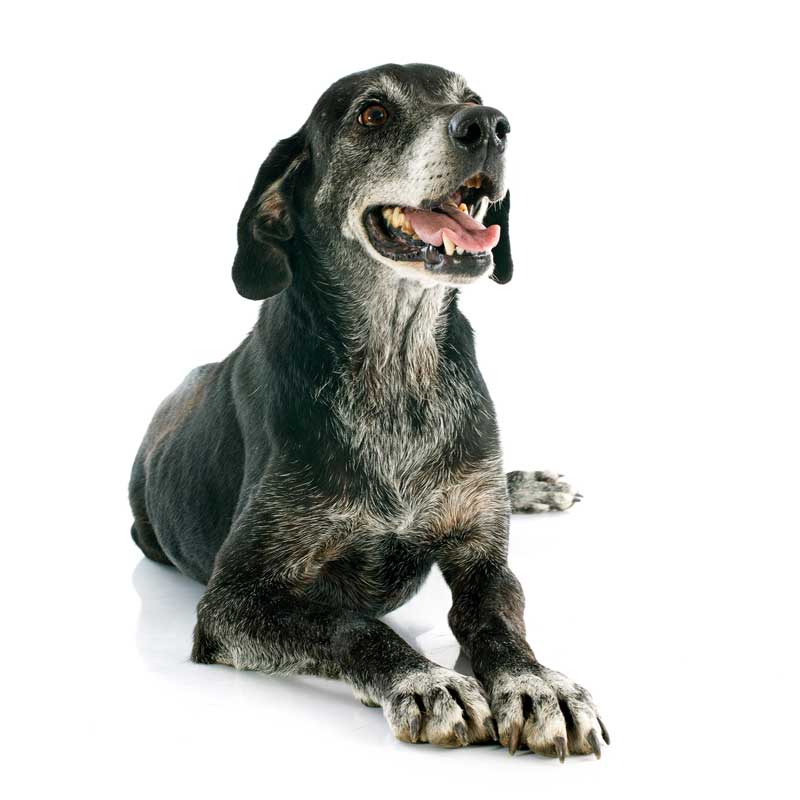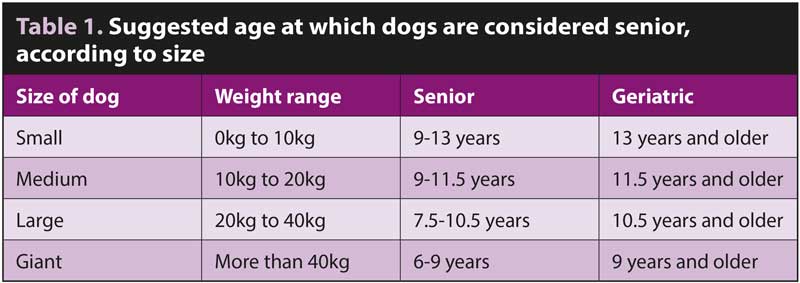10 Feb 2025
Sandra Wells BSc(Hons), discusses how this strategy can play an essential role in managing elderly pets in practice.

Image: © #CRTVTY/ Adobe Stock
Pets are living longer, and the demographic shift in the pet population is striking. Recent data shows that the lifespan of dogs has increased by approximately 5%, while cats have made even greater gains, with mixed breeds living nearly 14% longer, and purebred cats achieving a 9% rise in longevity1.
Looking further back, the transformation is even more dramatic: dogs are now living twice as long as they did 40 years ago2.
As a result, older pets make up 30% to 40% of patients in general practice3, a proportion that is expected to grow as the pet population continues to age.
Ageing is marked by a progressive decline in cellular, tissue and organ function. At the tissue level, ageing manifests as pathological changes including atrophy, fibrosis and fatty infiltration, all of which contribute to the decline in organ function4.
What makes this particularly challenging is that many of these pathological changes occur silently.
Additionally, the interconnected nature of organ systems means that dysfunction in one area can trigger a cascade, leading to a domino effect of multiple organ dysfunction5.
Pathological changes mean that as pets age, they are more prone to chronic illness and more likely to spend extended periods with age-related health issues3. However, many of the clinical signs of these age-related conditions are subtle or are dismissed by owners as “just old age”. This makes proactive geriatric care essential.
Routine clinicopathological testing plays an important role in identifying subclinical diseases before they progress to a stage where clinical signs become evident. Research highlights the value of this approach: in one study, 80% of apparently healthy dogs older than nine years were found to have at least one previously unrecognised health issue after routine screening, with an average of seven to eight health issues identified per dog6,7.
Detecting diseases in their early stages allows for timely interventions, better outcomes and enhanced quality of life.
A typical geriatric blood profile includes parameters to assess renal function, thyroid function, glucose metabolism and other key health indicators.
Chronic kidney disease (CKD) is one of the most prevalent conditions affecting senior pets – particularly cats. Its prevalence increases significantly with age, affecting approximately 1% of the general feline population8, but rising to as high as 80% in cats older than 15 years9.
CKD is also common in the canine population and can be very challenging to manage, with a shorter survival time compared to cats. The disease is typically advanced at diagnosis (International Renal Interest Society stage 3 or 4) and tends to progress rapidly with poor clinical outcomes10. Early diagnosis is key to improving the outlook for these patients.
Traditional markers such as serum creatinine are commonly used to assess renal function. Creatinine is produced at a steady rate due to muscle catabolism and is not reabsorbed by the kidneys after filtration. This means that measuring creatinine levels provides an indirect measurement of glomerular filtration rate (GFR).
However, the relationship between GFR and creatinine is not linear; creatinine levels may remain normal (less than 180µmol/L in the dog), until up to three-quarters of the nephrons are lost. Thereafter, further small losses of nephrons may result in substantial increases in creatinine levels.
Aligning with this, renal disease may remain subclinical until approximately 75% of renal function is lost11, making early detection challenging.
Symmetric dimethylarginine (SDMA) has emerged as a more sensitive biomarker for CKD detection12. While creatinine levels start to increase when 75% of renal function is lost, SDMA levels rise when approximately 40% of function is lost, and sometimes as little as 25%. Additionally, SDMA is less impacted by extrarenal factors such as loss of lean body mass, a common issue in ageing pets, making it a more reliable marker in these patients.
The International Renal Interest Society (IRIS) guidelines recommend assessing SDMA and creatinine levels together, with persistent elevation on repeat testing in a stable, hydrated patient, serving as an early indicator of CKD.
According to IRIS guidelines13, persistently elevated SDMA levels, even when serum creatinine is within normal limits, may indicate early-stage CKD (IRIS stage 1).
Neoplasia is another leading cause of morbidity and mortality in geriatric patients – particularly in dogs. In one study cancer accounted for nearly half of all deaths in older dogs14.
Early detection is critical, as identifying cancer in its early stages significantly improves the chances of effective treatment and better outcomes.
In human medicine, elevated levels of nucleosomes – small fragments of DNA released from cancer cells into the bloodstream – are strongly associated with tumour burden and malignant progression in several types of cancers15.
This same principle is applied in veterinary medicine with the Nu.Q Vet Cancer Test, which measures circulating nucleosomes using antibodies that specifically target these proteins. The Nu.Q Vet Cancer Test is useful for detecting cancers such as lymphoma and haemangiosarcoma16,17, even in their early stages. Preliminary evidence also suggests it may identify some instances of mast cell tumours, malignant melanomas and histiocytic sarcoma.
However, because nucleosome release is common across multiple cancer types, the test cannot differentiate between cancer types or their locations. Further diagnostics, such as imaging or biopsy, are required to confirm the diagnosis and determine the cancer’s origin.
Cancer screening of this type is a useful tool for senior wellness checks – particularly in senior dogs aged seven years or older. For breeds predisposed to developing cancer, such as the Labrador retriever, golden retriever and French bulldog, testing as early as four years old may be beneficial.
The benefits of early diagnosis are not just limited to cancer care or management of kidney disease. In dogs older than nine years, as many as seven major organ system problems may be present18. The risk of endocrine disorders such as diabetes mellitus, hyperadrenocorticism and hypothyroidism increases with age, as does the prevalence of conditions such as liver disease. Early diagnosis can help improve outcomes in these complex cases.

Senior health clinics offer an excellent framework for delivering this proactive, preventive health care to ageing pets, both canine and feline. These clinics focus on early detection, proactive intervention and ongoing management of chronic conditions. Moreover, demand exists for this type of care from owners, with 63% saying they would attend a preventive health clinic now or in the future3.
A personalised, contextualised care plan is essential for each individual pet, taking into account both owner preferences and also addressing the unique health needs of the pet, including breed predispositions where relevant. While care should be tailored, it is helpful to have a practice framework that can be adapted for each patient5.
Typically, senior health clinics include a thorough examination, blood tests and urinalysis. This approach can help identify specific diseases, but also serves a broader purpose in assessing general health. Routine haematology can reveal the presence of anaemia, indicate nutritional status and detect underlying inflammation, physiological stress or an inability to fight disease. Blood biochemistry provides insights into organ function and should include assessment of thyroid function.
Prompting owners to report subtle signs of illness is also important and a pre-appointment questionnaire can be helpful for gathering a comprehensive history.
Veterinary nurses play a pivotal role in these clinics by conducting initial assessments, educating pet owners and arranging a follow-up appointment with a veterinary surgeon when necessary. Even when no abnormalities are detected, results of blood and urine screening tests provide a useful baseline for future comparison.
So, at what point should routine screening or senior wellness checks start? The American Animal Hospital Association defines the senior stage as the last 25% of a pet’s expected lifespan19.
This occurs earlier for large and giant breeds compared to smaller breeds; for example, giant breeds may reach senior status at around six years of age, while smaller breeds may not do so until around 9 or 10 years of age.
Some sources also define an additional geriatric stage beginning from around 9 to 13 years depending on breed (Table 1). For cats, the International Society of Feline Medicine has defined three distinct age categories – mature (7-11 years), senior (11-15 years) and super senior (15 years and older).
 As pets live longer, the need for proactive health care becomes increasingly important. Ageing, while not a disease in itself, inevitably leads to physiological changes that heighten the risk of various clinical conditions.
As pets live longer, the need for proactive health care becomes increasingly important. Ageing, while not a disease in itself, inevitably leads to physiological changes that heighten the risk of various clinical conditions.
An annual screen for subclinical disease from seven years of age, or earlier for breeds predisposed to particular diseases, can have a positive impact on the health and well-being of pets. Diagnostic testing plays a pivotal role in identifying these issues early, allowing for interventions that can enhance both quality and quantity of life.